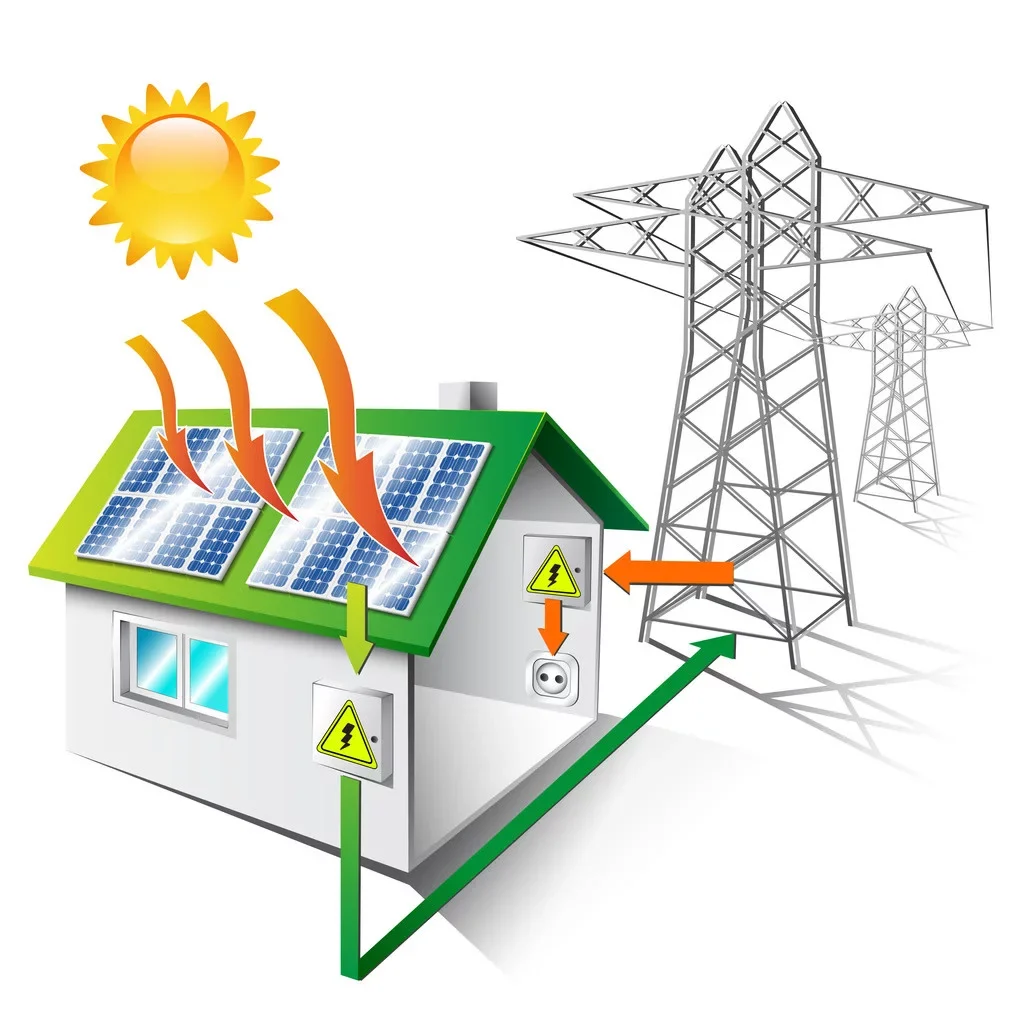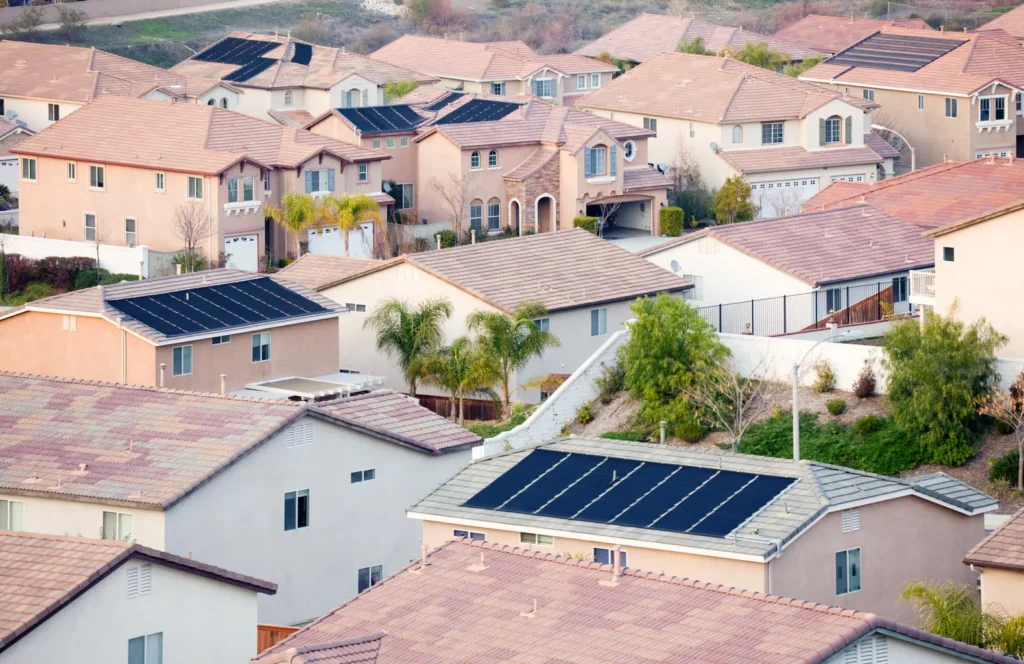Solar Panels 101
Solar panels convert sunlight into direct current or DC electricity. Direct current was discovered by Edison. This is current that flows continuously in one direction, such as in a fuel cell or battery.
Tesla discovered alternating current or AC electricity. He believed that alternating current was a better solution. Alternating current, which reverses its direction 60 times per second in the United States, can be easily converted to other voltages using a transformer.
Your energy consumption is measured by a meter which measures your energy use and accumulates credits when the sun is shining to be used later to offset your nightly electricity consumption.
Solar Panels 101 Side Effects: You end up with a lower power bill because we will bill you at one low predictable rate. No more 3 tiered system or time-of-use billing that costs you money.
The Best Way to Power Your Home
We will configure the perfect system for your home based on your specific needs at no cost to you. If you qualify, You simply need to agree to paying a lower electric bill.
Are Solar Panels the Right Option for Me?
Did I mention the panels and installation are FREE!

You must qualify for this program
- Are you the homeowner?
- Does your roof allow for solar panel installation?
- Is your electric bill is too high?
- Does your power bill fluctuate monthly?
- Are you concerned about leaving the lights on?
Financing
We offer No financing because there is no loan and nothing out of your pocket. We own the panels and simply sell you the electricity that is produced from the solar panels that we install on your home.
Solar Panels 101
Solar energy sometimes seems like a simple concept. Unfortunately, there’s much more to it than sticking a panel up and turning on the lights. Using solar energy as your primary source of electrical power requires a carefully designed system to be installed correctly. That’s the only way to achieve effective integration with other power sources and existing infrastructure.
If this all sounds too complicated, don’t worry. We have all the experience to explain solar panels 101. We’ll point you towards ideas and strategies that can help you figure out the best way to put a solar power system to work for you. Follow along through the best guide to solar panels.
Solar Energy: The Basics
Solar energy comes from the sun. Even though it’s millions of miles away, its radiation is a source of power. You just need the right equipment to harness it effectively.
What Is Solar Power?
The photovoltaic effect is a process whereby technology converts the energy in the sun’s rays into power. Photovoltaic cells harness the radiation from the sun, taking in raw energy. Then they convert that captured energy into electrical power.
What Are the Parts of a Solar Panel System?
A complete solar energy system is more than just a photovoltaic cell, commonly called a solar panel. Instead, the panel is just one part of the system. Multiple solar panels are called an array.
Anytime you’re building a solar panel system, whether it’s one panel or many, you need to mount it. A solar panel array mounts on racking, basically a foundation of metal grids that hold the panels in place.
After capturing the energy, an inverter works to convert it into electrical power that can be input into the electrical grid, your home, or an appliance. Some solar energy systems also have the capacity to store the energy harvested in batteries, so you can consume it later, perhaps when the sun is down overnight or when clouds block its rays.
Other Solar Power Considerations
Beyond the type and size of your solar panels and the system, they’re a part of, you have to consider other variables when discussing the design of solar power systems. Here are some important terms.
Off-Grid Versus Tied-in
If you’re using solar panels in concert with the existing commercial power grid, you can consume the energy you need and release the rest of the unused electricity back into the commercial supply. Some utilities will even compensate you for doing so. That’s called tying-in to the grid.
But, if you’re off the commercial grid (off-grid), perhaps in a remote location where there are no power lines providing energy, you can’t feed your surplus energy in the system. So, it then makes a lot of sense to maximize your efficiency by storing as much power as possible in batteries.

Hybrid Systems
Hybrid systems are tied-in, but they also have batteries for storing power. This kind of setup is popular because it allows a homeowner or business to feed energy back into the grid, nearly constantly earning them money while significantly reducing their energy costs.
When the solar system isn’t meeting demand due to weather, accumulated snow, or a maintenance issue, ample supply is available through the commercial grid. And, when the commercial experiences an interruption, there is not only available energy from the solar panels but stored, reserve power in the battery system.
Batteries
Batteries can often cost as much or more than the rest of your system. They’re usually the priciest component of a solar energy project. Many companies, like Tesla and Panasonic, are working to increase the capacity of batteries while also making them more efficient, friendly to the environment, and affordable.
Inverters
After harvesting energy from the sun and converting it to electricity, solar cells have done their work. But most household appliances still can’t use the electricity output by a cell. That’s because it’s DC or direct current. So, you’ll need an inverter to transform that DC voltage into Alternating Current or AC power.
Some systems feature micro-inverters at each panel. Other systems tie multiple panels into a single, larger inverter. For even larger systems, there may need to be various inverters, each linked to a string of solar panels.
Additional Components
You may also need additional components to make the whole system work, so if you’re thinking about installing a solar power system, consider that in addition to the panels, racking, and batteries, you’ll also need:
- A charge controller to adjust the rate at which you send energy to the batteries
- A voltage monitor to keep an eye on your output (so you can fine-tune the system and remain aware of problems)
- Fuses
- Electrical wiring
- Safety disconnects
Exploring Solar Panels
Let’s look more closely at the workhorses of solar energy systems, the solar panels themselves.
Solar Panel Construction
Photovoltaic (PV) technology refers to devices and materials that can convert sunlight into electrical energy. A cell is one single PV device, usually with the ability to produce just a watt or two of power.
Since a single cell doesn’t output that much power, they’re usually part of photovoltaic panels. Solar panels, or modules, as they’re sometimes called, can also connect with other panels, forming an array. Some system designs will have multiple arrays. This modular design allows solar energy system engineers and designers to tailor each build to the site’s specific layout and its energy demand.
What Are Solar Panels Made Out of?
Most solar panel cells might be best thought of as a sandwich, built in the shape of a window. The bread or outer layer of the solar panel sandwich consists of durable, protective materials that house the photovoltaic cells.
The backing is rigid and tough, with the cells laid on top and then covered with a layer of glass. Once the sandwich is complete, the cells live between the protective layers, allowing them to last outdoors for years.
Scientists are hard at work making PV cells more efficient and thinner. Some new ultra-thin cells still in development are thinner than a single human hair.
What Are the Different Types of Solar Panels?
Solar panels use three different designs to harness the sun’s energy. They all perform the same task, but their source components and design are different.
Monocrystalline Panels
Monocrystalline panels are probably the most common type and feature wafers of silicon sourced from single crystals, sliced into thin layers. They have an optimal life span of nearly forty years, making them the most durable. They also have an efficacy rate of about 15-20%, ranking them at the top of all designs.
Mono panels are dark, almost black, making them the easiest to camouflage. So, this type of panel is used for projects like solar roofs or solar shingles, as they blend well with the rest of the structure. They’re also the most environmentally friendly in terms of their construction.
Polycrystalline Panels
Polycrystalline panels don’t have wafers from single crystals. Instead, their manufacturing starts with many fragments of silicon, which are then melted and poured into a mold. This manufacturing technique requires less raw material, but the resulting panel is less efficient, at only 20%. They also have a shorter life span and lower heat tolerance.
They’re distinctively blue-hued, so they’re hard to blend with other structures and require more space than mono panels to capture the same amount of energy due to their lesser efficiency.
Thin-Film Panels
Thin-film solar panels are the least efficient solar panels currently on the market. The cells themselves consist of very thin layers of semiconductors, like silicon, cadmium telluride, and copper indium gallium selenide. These materials are less efficient than both poly- and monocrystalline panels, but they are the best-looking type of solar panel.
Thin-film panels also offer the least durability, but they remain popular because they are also the least expensive.
How Big Are Solar Panels?
A single solar cell is pretty tiny, about six inches wide and long. Thin solar cell panels usually come in two standard sizes, with either 60 or 72 cells. This standard helps builders, as they can more easily install the racking that the panels mount into. Otherwise, each solar project would require completely customized construction.
60-cell solar panels are 39″ x 65″ while 72-cell panels are 39″ x 77″. There is some slight variability in frame size, but these are industry standards. However, some manufacturers produce specialized panels with different dimensions. For instance, there are much smaller options for mobile use, and some manufacturers are working on making larger 96-cell panels.
Solar Panels Pros and Cons
In general, there are some pros and cons to consider when discussing solar power or planning to install panels.
Pros
- Using solar power doesn’t deplete the sun’s energy, whereas fossil fuels are a limited resource.
- Solar power is viable even in areas without an electrical grid.
- Solar panels can boost a home’s value, particularly if the house is in a remote location.
- Using solar panels can reduce, or in some cases eliminate, your electric bill.
There are even some arrangements where you pay nothing out of pocket for the initial installation of the solar panels. Typically, in this setup, a company will own and install the panels on your roof and then sell you electricity at a cheaper rate than your utility. They also sell energy to the grid.
Cons
- Even relatively small solar energy systems have a high up-front cost.
- Shade, clouds, snow, and other weather phenomena can reduce the available energy on any given day. Without abundant sunshine, solar collectors can’t harness energy.
- Solar energy systems take up a lot of space and sometimes require many panels or even multiple arrays to meet demand.
- Batteries to store the harnessed energy can be extremely expensive.
Are Solar Panels Good for My Home?
Rooftop solar panels perform best on south-facing roofs with a pitch between fifteen and twenty degrees. Along with the orientation of your home and the design of its roof, shade from trees and other structures has a massive impact on a solar array’s ability to harness energy from the sun.
If your solar system professional doesn’t think your roof is a feasible solar site, you may be able to install an array elsewhere on your property. Or, you may be able to take advantage of the community solar market, which leverages off-site solar panel locations as a shared energy source for multiple users.
In the community solar market, everyone shares in the initial installation costs, cutting down on the expense to the individual. Then, once it’s in place, everyone shares in the benefits. A monitoring system can determine how much power gets allotted to each user.
Can I Finance Solar Panels?
For the best, fastest return on your investment, purchasing your solar system and owning it outright is ideal. Doing so makes you eligible for a Solar Investment Tax Credit, a federal program that incentivizes the installation of solar systems. Unfortunately, however, many federal solar incentives are due to expire without further action from Congress.
It’s also relatively easy to purchase a solar system through a loan, lease, or power purchase agreement. New homeowners can even utilize a federal loan program to borrow funds to finance the construction of a solar panel system.

Solar Panels 101: Wrap Up
Solar panels are a proven source of renewable energy. However, despite their effectiveness, they have obvious limitations that affect their feasibility for some projects. For instance, in areas where there is less sunlight on a daily basis, there is a corresponding lack of energy available to harvest.
However, research and development of solar panel technology are ongoing. Paired with advanced batteries that can store more and more power in smaller units, solar power systems represent a clear path to diversifying our energy consumption across more sources, potentially significantly reducing our reliance on fossil fuels.
Now that you know all of the basic information, you’re ready to start thinking about how solar panels can help you save money and reduce your carbon footprint.

